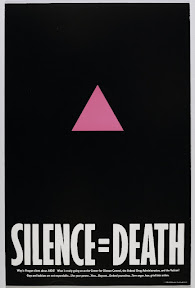Act Up’s campaign poster “Silence = Death” (1987) is a powerful piece of activist art that features a stark, black-and-white design. The poster shows a bold pink triangle with the words "SILENCE = DEATH" in capital letters. The triangle, a symbol associated with the gay rights movement and AIDS awareness, is designed to grab attention and convey urgency. I chose this work because it embodies a significant moment in the AIDS activism movement, reflecting the intense frustration and determination of the time. The poster’s design is simple yet striking, making it an effective tool for rallying people around the cause and demanding action.
The "Silence = Death" poster was created by the AIDS Coalition to Unleash Power (Act Up) to protest the government’s inadequate response to the AIDS crisis. The message of the poster is a powerful condemnation of the silence surrounding the epidemic and the lack of effective action to address it. The use of the Pink triangle was also used in Nazi concentration camps to mark homosexuals, underscores the urgency and seriousness of the issue.
The artwork is activist in its direct and confrontational approach. By using a simple yet powerful slogan and a recognizable symbol, it effectively communicates the urgency of the AIDS crisis and the need for immediate action. The poster’s design and message were intended to mobilize people, challenge complacency, and pressure authorities to respond more vigorously to the epidemic.
1. WHY ARTISTIC ACTIVISM?
"Artistic Activism is a practice aimed at generating Æffect: emotionally resonant experiences that lead to measurable shifts in power."
"Artistic activism creates an opportunity to bypass seemingly fixed political ideas and moral ideals and remap cognitive patterns."
Artistic activism merges emotional engagement with strategic impact, making it a powerful tool for social change. It disrupts expectations, opening space for new perspectives and action by blending art’s emotional power with activism’s concrete goals.
2. An Introduction to Activist Art
“Activist art seeks to provoke thought and inspire action by addressing social, political, and environmental issues. It is often characterized by its commitment to change and its use of creativity to engage audiences in critical dialogue.”
“By using art as a tool for activism, artists can challenge dominant narratives and offer alternative perspectives. This form of art can be a powerful means of raising awareness, mobilizing communities, and fostering social justice.”
These quotes show how activist artworks inspire change and offer new viewpoints. The first quote points out that activist art’s main purpose is to get people thinking and acting on important issues. The second quote highlights that activist art challenges common beliefs and provides fresh ideas, helping to raise awareness and support social justice.
3. "The 25 Most Influential Works of American Protest Art Since World War II"
“Protest art is a vital form of resistance that uses creativity to voice dissent and challenge injustices. It serves as a powerful tool for raising awareness and fostering change.”
“Throughout history, protest art has played a crucial role in social movements by reflecting the struggles and aspirations of marginalized communities, pushing for progress and reform.”
These quotes highlight the importance of protest art in social movements. The first quote explains that protest art is a way to express opposition and highlight issues through creativity, helping to raise awareness and drive change. The second quote shows how protest art has been essential in documenting the experiences of marginalized groups and advocating for progress. Both quotes underline how protest art reflects and influences social and political change.

No comments:
Post a Comment